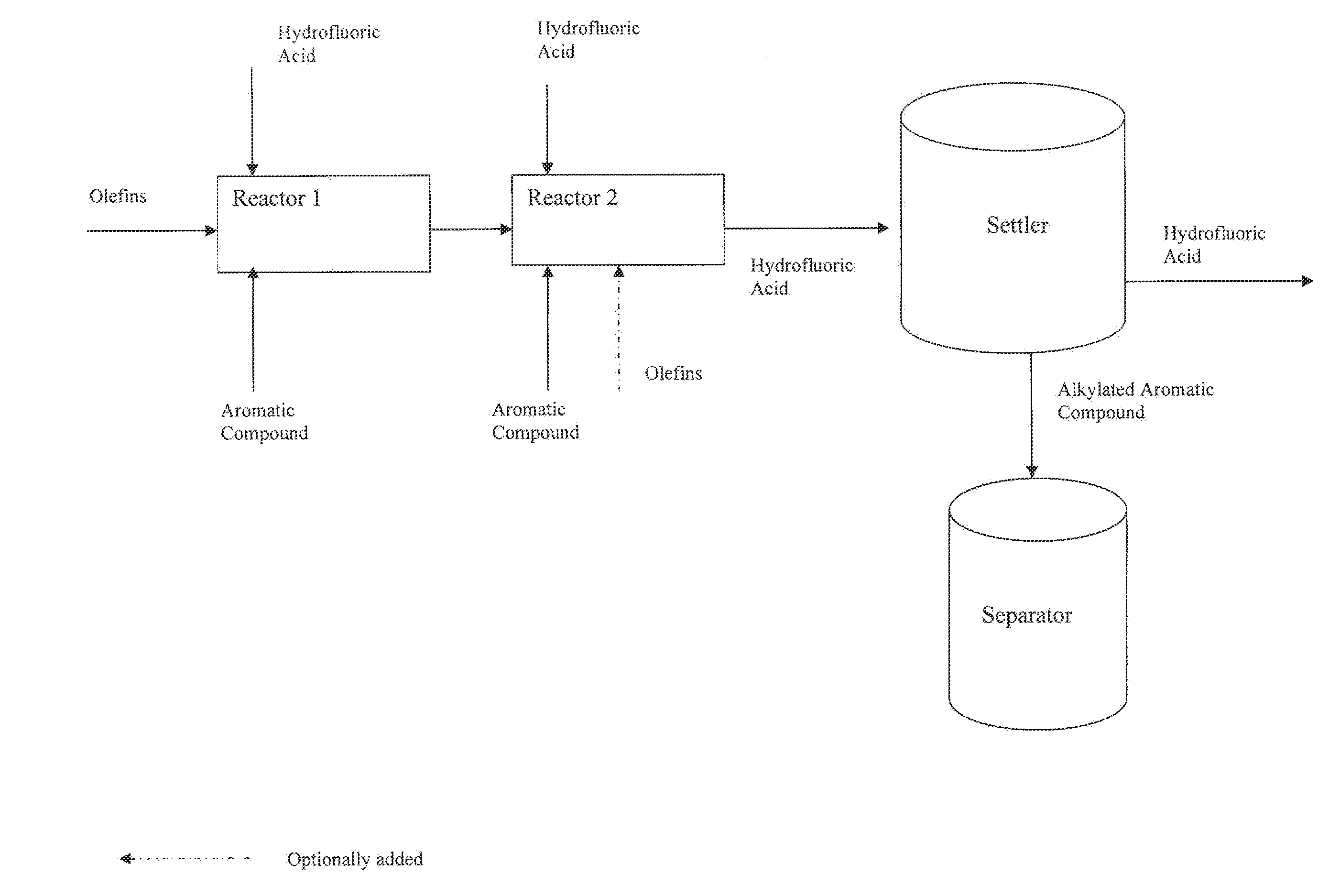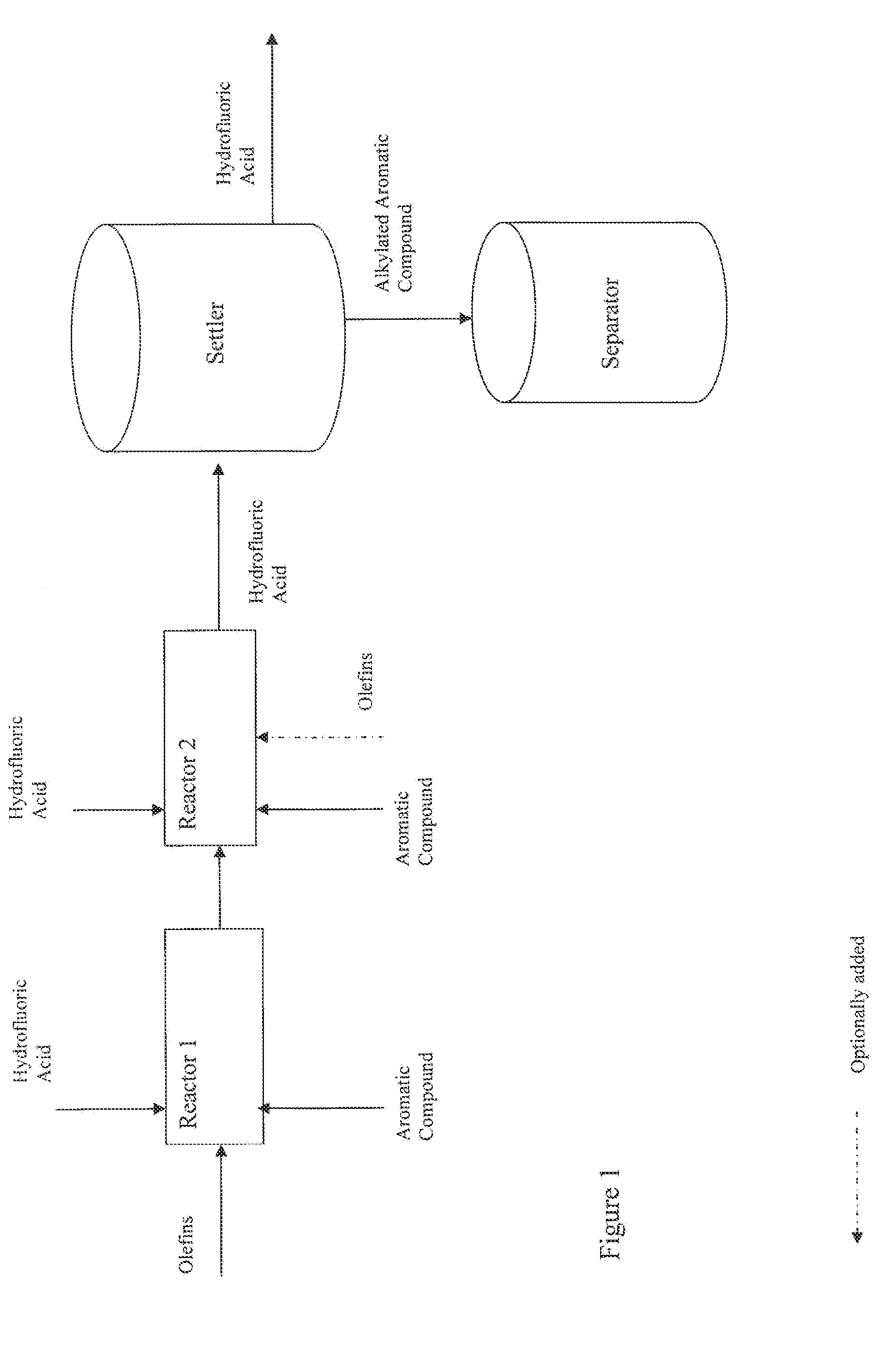Method of making a synthetic alkylaryl sulfonate
a technology of alkylaryl sulfonate and synthetic alkylaryl sulfonate, which is applied in the field of making synthetic alkylaryl sulfonate, can solve the problem of difficult alkylation of benzene with higher olefins
- Summary
- Abstract
- Description
- Claims
- Application Information
AI Technical Summary
Problems solved by technology
Method used
Image
Examples
examples 1-3
Alkylation of Ortho-Xylene with C14-30+ NAO Using Two Alkylation Reactors in Series
[0056]The alkylated ortho-xylenes of Examples 1-3 were prepared in a continuous alkylation pilot plant using hydrofluoric acid (HF) in which two alkylation reactors (1.15 liter volume each) were in series followed by a 25 liter settler to separate the organic phase from the HF phase. All equipment was maintained under a pressure of 5 bar and the reactors and settler were jacketed to allow temperature control. In addition, the alkylation reactors were configured such that the ortho-xylene, normal alpha olefins (NAO) and HF could be fed to each reactor at a specified rate.
TABLE 1ExampleReaction Conditions123Reactor 1HF / Olefin Vol. Ratio0.70.70.7Xylene / Olefin CMR1.41.41.4Temperature (° C.)647070Reactor 2HF / Olefin Vol. Ratio111Xylene / Olefin CMR7.57.57.5Temperature (° C.)606060* The CMR in Reactor is the cumulative ratio, which includes Reactor 1 reactants.
[0057]Following the settler, the organic phase was...
examples 4-7
General Procedure for Sulfonation and Neutralization of Alkyl Ortho-Xylene Alkylate
[0060]Sulfonation of the alkylxylene was performed in a continuous falling film flow reactor by contacting the alkylxylene with a stream of air and sulfur trioxide. The molar ratio of the alkylxylene to sulfur trioxide ranged from was about 1. Detailed values are given in Table 3. The reactor jacket was maintained around 60° C. The sulfonic acid product was titrated potentiometrically with a standardized cyclohexylamine solution to determine the weight percent of the sulfonic acid (as HSO3) and the sulfuric acid (H2SO4) in the samples, Results are shown in Table 3.
[0061]The resulting alkyl ortho-xylene sulfonic acids were converted to their corresponding sodium salt by treatment with one equivalent of aqueous NaOH (50% aqueous NaOH solution). The salts were evaluated by the Fresh Interfacial Tension (FIT) Method. This procedure was as follows:[0062]1) A 3.0 wt % stock solution of alkyl ortho-xylene so...
example 8
Infrared Method to Determine Relative Percentage of 1, 2, 3 Alkyl and 1, 2, 4-Alkyl Aromatic Ring Attachment
[0068]The infrared spectrum of a sample of alkylated ortho-xylene product was obtained using an Infrared spectrometer (Thermo model 4700) equipped with a rebounce diamond attenuated reflectance cell. The absorbance spectrum of the sample between 600 and 1000 cm−1 was displayed and the peaks at about 780, 820, and 880 cm−1 were integrated. The relative percentage area of each peak was calculated and the percent 1, 2, 3-alkyl aromatic content is represented by the relative area percentage of the 780 cm−1 peak.
PUM
| Property | Measurement | Unit |
|---|---|---|
| Percent by mass | aaaaa | aaaaa |
| Percent by mass | aaaaa | aaaaa |
| Fraction | aaaaa | aaaaa |
Abstract
Description
Claims
Application Information
 Login to View More
Login to View More - R&D
- Intellectual Property
- Life Sciences
- Materials
- Tech Scout
- Unparalleled Data Quality
- Higher Quality Content
- 60% Fewer Hallucinations
Browse by: Latest US Patents, China's latest patents, Technical Efficacy Thesaurus, Application Domain, Technology Topic, Popular Technical Reports.
© 2025 PatSnap. All rights reserved.Legal|Privacy policy|Modern Slavery Act Transparency Statement|Sitemap|About US| Contact US: help@patsnap.com


